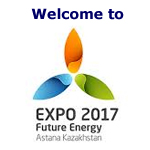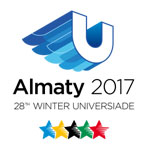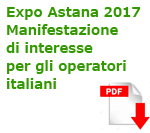
Kazakhstan plans to launch Kartaly (Russia) – Astana gas pipeline in third quarter of 2014
 Kazakhstan plans to launch Kartaly-Astana gas pipeline in the third quarter of 2014, Kazakh National Company KazMunaiGas told Trend via e-mail on Friday.
Kazakhstan plans to launch Kartaly-Astana gas pipeline in the third quarter of 2014, Kazakh National Company KazMunaiGas told Trend via e-mail on Friday.
According to KazMunaiGas, the feasibility study of the project has been revised and the updated project envisages reduction of pipeline capacity from 6 to 3 billion cubic meters of gas.
“Following a series of meetings in Kazakh Oil and Gas Ministry with design institutes (Kazakh Oil and Gas Institute and KATEK Design and Research Company) and Kazakh Agency for Construction and Housing, a decision was taken to optimize the technical and economic indicators of the feasibility study in accordance with consumption in near-term period without transfer of industrial consumers and consumers of fuel and energy complex to natural gas,” KazMunaiGas said.
The project optimization has been approved by the Kazakh President.
According to KazMunaiGas, West-North-Centre main gas pipeline construction through Tobol — Kokshetau — Astana will cost 208.4 billion tenge. The construction of the Kartaly — Astana pipeline is scheduled to start in 2013. The pipeline will run from Russian Kartaly through Kazakh Kokshetau and Kostanay to Astana. The pipeline will supply Russian gas to Kazakh city of Astana.
Kazakhstan-Turkey to increase bilateral trade volume up to $10 bln
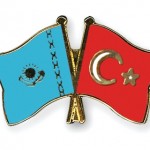 Kazakhstan and Turkey signed an action plan within New Synergies program. The program envisages increase of bilateral trade volume up to $10 billion and annual $500-million increase in volume of investment, Kazakh presidential press-service reported.
Kazakhstan and Turkey signed an action plan within New Synergies program. The program envisages increase of bilateral trade volume up to $10 billion and annual $500-million increase in volume of investment, Kazakh presidential press-service reported.
“We hope that the Turkish investors will continue to work actively in Kazakhstan. Today we discussed the establishment of the Kazakh-Turkish industrial zones. Also it was agreed to increase the efficiency of the economic commission of the two countries,” Kazakh President Nursultan Nazarbayev said at the press-conference following a meeting with Turkish Prime Minister Recep Tayyip Erdogan.
According to Nazarbayev, the today’s Kazakh-Turkish business forum opens up great opportunities for development of business partnership between the two countries. Some 50 representatives of Kazakh companies and 600 representatives of Turkish companies will take part in the forum. Some 13 bilateral agreements worth $1 billion are expected to be signed within the forum.
In turn, Turkish Prime Minister Recep Tayyip Erdogan said that Kazakh President’s visit raised the relationship between the two countries to a new level.
A loan agreement signed between Kazakhstan and the World Bank
 A Loan Agreement on the East-West Roads Project (Almaty-Khorgos section): the International transit corridor Western Europe – Western China (CAREC 1b)” was signed today between the Republic of Kazakhstan and the World Bank.
A Loan Agreement on the East-West Roads Project (Almaty-Khorgos section): the International transit corridor Western Europe – Western China (CAREC 1b)” was signed today between the Republic of Kazakhstan and the World Bank.
The new 305 kilometers road from Almaty to Khorgos to be opened in 2015, being a transit link between China and Kazakhstan and other Central Asian countries, has a great potential to accelerate trade flows and economic prospects to boost the regional economy.
“The East-West Roads Project signed today will complete the upgrade of the Western Europe-Western China Road Corridor,” says Bolat Zhamishev, Minister of Finance of the Republic of Kazakhstan. “Aimed at improving the efficiency of the transport link from Almaty – one of the main economic centers of Central Asia – to Khorgos, the main road border crossing between Kazakhstan and China, the Project will help improve access to markets, enhance business opportunities, and create more jobs”.
Continua a leggere
Fotovoltaico: Bisol Group svilupperà un impianto da 2 MW in Kazakistan
 L’azienda ha firmato un contratto con l’investitore Samruk-Energo per costruire e installare un impianto FV a terra e con inseguitori solari nella città di Kapchagay nella provincia di Almaty.
L’azienda ha firmato un contratto con l’investitore Samruk-Energo per costruire e installare un impianto FV a terra e con inseguitori solari nella città di Kapchagay nella provincia di Almaty.
BISOL Group, uno dei principali produttori europei di moduli FV e altre soluzioni solari di qualità superiore, è attivo anche nel campo dell’ingegneria, dell’approvvigionamento e della costruzione di interi impianti FV e ha firmato un contratto per costruire un impianto FV da 2 MW in Kazakistan.
Essi hanno scelto BISOL Group come fornitore sulla base della vasta esperienza internazionale nell’implementazione di vari progetti fotovoltaici, che sono supportati dalla produzione dei propri prodotti solari di alta qualità. Una volta completato, il gestore e il proprietario dell’impianto fotovoltaico sarà Samruk-Green Energy, società controllata da Samruk-Energo.
Eni: in Kazakhstan produzione raddoppiata entro il 2020
In Kazakhstan la produzione netta di Eni è al momento pari a circa 100.000 boe/giorno e sarà raddoppiata entro il 2020. Lo ha affermato Massimo Mondazzi, Executive Vice President Central Asia, Far East & Pacific, nel corso dell’ Upstream seminar. Per quanto riguarda il giacimento di Kashagan, ha spiegato, attraverso la realizzazione delle rimanenti infrastrutture onshore e offshore, si prevede l’avvio della produzione commerciale ben prima di giugno 2013, data concordata con la Repubblica del Kazakhstan. Riguardo a Karachaganak, le riserve ancora da produrre sono stimate in circa 5 milioni di barili e i costi di produzione sono ben al di sotto della media di Eni. Sempre a Karachaganak, la società si attende un’ulteriore sostanziale crescita della produzione di gas a partire dal 2019/2020
Kazakhstan-Turkmenistan-Iran railway has historical importance
 The upcoming completion of constructing the transnational railway Uzen-Gyzylgaya-Bereket-Etrek- Gorgan connecting Kazakhstan, Turkmenistan and Iran is a historic event in the life of the three neighboring countries, Kazakh Chargé d’Affaires to Turkmenistan Mukhamedkali Bakbergenov said today.
The upcoming completion of constructing the transnational railway Uzen-Gyzylgaya-Bereket-Etrek- Gorgan connecting Kazakhstan, Turkmenistan and Iran is a historic event in the life of the three neighboring countries, Kazakh Chargé d’Affaires to Turkmenistan Mukhamedkali Bakbergenov said today.
The appeal is timed to the 20th anniversary of establishing the diplomatic relations between Kazakhstan and Turkmenistan.
It is stressed that the transnational North – South corridor will give a powerful impetus to the further economic development of the three countries.
“The new railway will optimize the route of transporting oil products from the Caspian Sea to the Middle East and reduce it by more than 600 km and transportation period – for 2 days compared to the current route,” the message says.
The countries signed an intergovernmental agreement on the international railway border crossing point at the Kazakh-Turkmen border in Ashgabat in May 2012.
The “North-South” project will open the way for the European and Asian countries to the Central Asia and the Persian Gulf. A similar opportunity will appear for the transit of goods from the countries of South and South-East Asia, the Indian Ocean to the Northern and Eastern Europe through Iran, Turkmenistan, Kazakhstan and Russia.
According to the preliminary forecasts, 3.5 million tons of cargo a year will be initially transported. The volumes will increase to 10-12 million tons in the future. The intergovernmental agreement on the “North-South” project between Kazakhstan, Turkmenistan and Iran was signed in 2007.
Astana, una capitale in costante evoluzione

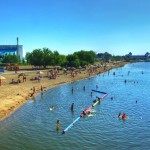
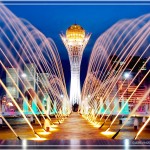

 In Kazakhstan l’accesso al mare è lontano migliaia di km, il Paese infatti è privo di sbocchi sul mare, se escludiamo il bacino del Caspio.
In Kazakhstan l’accesso al mare è lontano migliaia di km, il Paese infatti è privo di sbocchi sul mare, se escludiamo il bacino del Caspio.
Estate. Le temperature sfiorano i 30°. Quello che ci vuole è una bevanda fresca e un tuffo in acqua. Ad Astana la vita è relax.
Astana significa capitale, ma la città, localizzata nel centro-nord del Paese, ha ottenuto questo status soltanto nel 1998.
Giugno è tra i mesi più caldi dell’anno e il week-end è il momento in cui si esce e ci si rilassa vicino all’acqua. Al di là di queste immagini estive, Astana è ufficialmente la seconda capitale più fredda al mondo.
Durante l’inverno le temperature scendono a – 30°i centigradi, ecco perchè tutti approfittano dei raggi di luce appena possono.
Per Yuri Leonidovich, capitano della barca turistica in navigazione sul fiume Yessil: “Lavorare su questa barca è un’esperienza interessante. Le persone escono dal lavoro, vanno a casa, si cambiano e corrono a rilassarsi qui, all’aria fresca”.
Il fiume Yessil è parte del Parco Centrale della città, una vera attrazione per le famiglie.
Il fiume caratterizza questa città. Sul lato destro troviamo il centro storico, mentre a sinistra pulsa la nuova Astana. Qui grattacieli ed edifici avveniristici cercando di avvicinare la capitale al resto del mondo. Per Astana gli investimenti sono vitali. Moody’s ha classificato il Paese tra le economie stabili.
L’apertura al mercato esterno, è una vera priorità per il Paese, che ha sofferto in passato di isolamento dal resto del mondo. Come racconta Yerlan Kozagapanov, vicesindaco di Astana: “È un chiaro segnale per gli investitori stranieri, possono fidarsi di noi e quindi investire nella nostra economia”.
La musica rimane l’anima della città, nonostante Astana abbia visto innalzarsi grattacieli e palazzi per oltre 4 milioni di metri quadri negli ultimi tre anni. È una città giovane che ha l’ambizione di lasciare traccia dietro di sé nel mercato asiatico.
Il clima la rende però una città proibita. E non c‘è dubbio sul fatto che la sua posizione geografica, al centro della steppa, abbia aumentato i costi di questo rinnovamento scintillante. Non si è trattato, infatti, di una transizione facile. Se come è vero i palazzi sono letteralmente cresciuti attorno alle persone.
Come racconta Damir Alimov, costruttore in pensione: “Era difficile camminare per le strade di Astana. Dal mio quartiere al centro, ad esempio c’era fango dappertutto, sia in autunno che in primavera. Molti indossavano degli stivali soltanto per arrivare alla fermata dell’autobus. Ora è tutto cambiato”.
Ma a cambiare è anche il volto dell’Astana notturna. I giovani della capitale hanno imparato bene come divertirsi la sera. I dj che s’incontrano nei locali dicono però di essere ancora dipendenti dalle tendenze americane ed europee.
Kazenergy Eurasian Forum : si discute del gasdotto Transcaspian
 Il Kazakistan secondo gli esperti diventerà prima della fine del decennio uno dei cinque principali esportatori di gas e petrolio.
Il Kazakistan secondo gli esperti diventerà prima della fine del decennio uno dei cinque principali esportatori di gas e petrolio.
L’Eurasian Forum di Astana, arrivato alla sesta edizione, è servito dunque a riunire i principali attori nazionali e internazionali del settore energetico.
Il commissario europeo all’energia Guenther Oettinger ha invitato le autorità kazake a collaborare al progetto di costruzione del gasdotto TranCaspian che dovrebbe collegare i paesi dell’Asia centrale all’Europa senza passare per la Russia.
Sul Caspio il Kazakistan sta costruendo una gigantesca piattaforma offshore che inizierà a funzionare nel 2012. All’incontro di Astana hanno preso parte anche i rappresentanti dell’ Eni.
Kazenergy: quanto durerà il petrolio ?
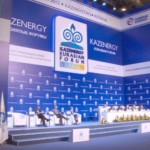
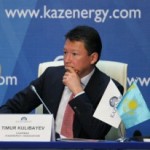
 Sempre più raro e prezioso. Il petrolio è il protagonista al Kazenergy Forum di Astana, al quale hanno partecipato i rappresentanti della Camera di Commercio Italo-Kazaka. E il petrolio sarà protagonista anche sulla scena politico-economica dei prossimi decenni. Stimato raddoppio delle domanda energetica mondiale per il 2050 e allarme per le risorse del futuro dettano come imperativo quello della caccia a nuovi e sempre più costosi giacimenti.
Sempre più raro e prezioso. Il petrolio è il protagonista al Kazenergy Forum di Astana, al quale hanno partecipato i rappresentanti della Camera di Commercio Italo-Kazaka. E il petrolio sarà protagonista anche sulla scena politico-economica dei prossimi decenni. Stimato raddoppio delle domanda energetica mondiale per il 2050 e allarme per le risorse del futuro dettano come imperativo quello della caccia a nuovi e sempre più costosi giacimenti.
“Il domani sarà caratterizzato da prezzi del petrolio che resteranno ancora ancora elevati – spiega Renato Bertani, presidente del World Petroleum Council -. Il perché risiede nel fatto che sempre più stiamo ora guardando al futuro. Nei prossimi decenni il petrolio resterà ancora la principale risorsa energetica e visto l’incremento della domanda, dobbiamo spingerci alla ricerca di nuovi giacimenti in aree sempre più impervie, difficili e quindi costose da esplorare e sfruttare”.
Culla di uno dei progetti più ambiziosi è proprio il Kazakhstan. E’ qui, che nel 2000 è stato localizzato il giacimento offshore di Kashagan: salutato dagli esperti come il più ricco dell’ultima quarantina anni, dovrebbe nascondere riserve fino a 16 miliardi di barili. Complessità e costi di uno sfruttamento a più riprese rinviato stanno però facendo meditare la ritirata alla statunitense Conoco Philips.
Kazakhstan to invest over $6 bln in modernisation of oil refineries before 2016
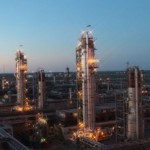 The Kazakhstani National Petroleum Company KazMunaiGas plans to invest more than six billion U.S. dollars in the modernisation of the republic’s three oil refineries, which will make it possible to increase oil processing to 19.5 million tonnes a year from the current level of 12 million tonnes, Company CEO Lyazzat Kiinov said at the Seventh Eurasian KazEnergy Forum, which opened here on Tuesday.
The Kazakhstani National Petroleum Company KazMunaiGas plans to invest more than six billion U.S. dollars in the modernisation of the republic’s three oil refineries, which will make it possible to increase oil processing to 19.5 million tonnes a year from the current level of 12 million tonnes, Company CEO Lyazzat Kiinov said at the Seventh Eurasian KazEnergy Forum, which opened here on Tuesday.
“The total value of investment in the fulfillment of the projects for the upgrading of the refineries is expected to exceed six billion U.S. dollars in the period from 2013 to 2015,” he said.
In his estimate, the implementation of the projects will allow the republic to raise the amounts of oil refinery, as well as to achieve the processing depth of 80-90 percent and raise the gasoline quality to the Euro-4 and Euro-5 standards, Itar-Tass reports.







